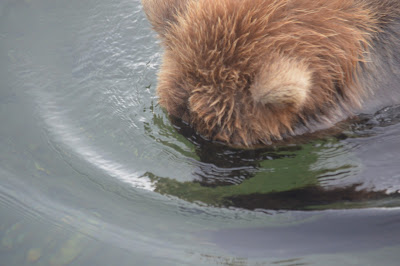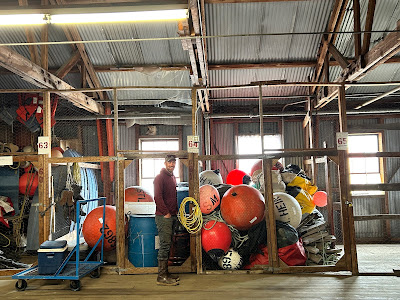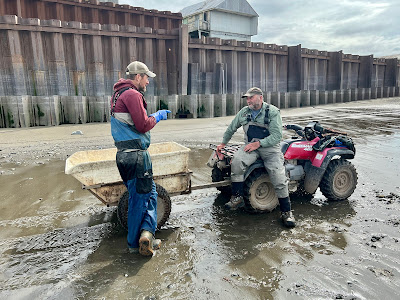The young boy, his pants rolled to his knees, was throwing pumice rocks into the lake and watching them float back to shore. It’s a fascinating phenomenon seeing rocks float! His parents, more tired than interested, lay on the beach, their heads cradled by daypacks. We all were enjoying the sun’s warmth, which we had felt infrequently all summer, while waiting transportation back to King Salmon.
I saw the young bear approach from the far end of the beach. The boy kept playing and his parents, with eyes closed, were oblivious to the bear. The boy’s arm had just completed a throw and as he turned back toward the beach he saw the bear and let out a scream to alert his drowsy parents.
At Katmai National Park, bears have the right of way, so we did as we had been instructed at Katmai’s mandatory bear school and cleared the beach allowing the bear to pass.
Katmai NP is located on the Alaska Peninsula and is only accessible by boat or airplane.
Folks travel here during July and August when Sockeye Salmon are moving from the ocean into fresh water to spawn. Within the park, salmon travel up the Brooks River to Brooks Lake. Brown bears, hungry from winter hibernation, follow the fish. The salmon often congregate at the base of Brooks Falls where they are forced to navigate the falls in their journey to the lake.
The bears are intent on catching fish and pay little attention to humans. It's a very unique situation.
 |
| Looking for fish |
 |
| Spring cub |
 |
| Claws! |
We camped at Brooks campground, operated by the National Park Service. It's no frills camping with a limited number of sites in high demand. Campers choose a spot when they arrive. Ours was a last minute booking the result I'm sure of a cancellation. Sites in July are fully booked by those wanting to see the bears. I felt comfortable knowing the entire campground was surrounded by electric fence. This has been added since our first visit in 2008. Our camp site close to the beach
Our friend, Carter, is a “Bristol Bay fisherman”. Bristol Bay is the world’s largest salmon fishery. Highly valued sockeye salmon are harvested for approximately four weeks during the end of June and through July. We arrived at the season’s end. Over 1500 drift boats using gill nets and about 1000 permitted gill nets are set from shore in and around Naknek, AK during sockeye season. For this reason, Carter operates his fish camp about 3 miles from town on Pederson Point, an area well known to salmon fishermen. Although Carter's commercial fishing season was nearly over, the sockeye were still present and he generously placed two nets out. Each set net runs from shore to an anchor offshore. These nets are 150' long and are gill nets, catching the salmon as they swim through by their gills.
Carter's camp is a cluster of well built cabins overlooking the bay. Despite their solid construction, the strong bay winds have occasionally tipped them over. We stayed in the foremost cabin which has three bunks. The large grey cabin is the kitchen and lounge complete with comfy leather couch. There are two outhouses and a "sauna" in which to dry waders and wet gear.
Other fish camps on the bluff
Many drift boats had been pulled and were being prepared for winter storage, but some remained at sea and I watched them set their nets. There also were set nets still in use along the beach.
Naknek had several large canneries still operating late in the season, however, the main topic of conversation was the low price being paid to fishermen for salmon. One cannery was paying $.50 a pound while another paid $1,00. This is considerably less than last year. The following link explains the situation.
 |
Carter in front of his locker at Pederson Point cannery. This facility dates back to 1890 and was fascinating to walk through. It’s a town unto itself with power plant, fresh water supply, laundry, lodging, mess hall, recreation area etc. https://www.northpacificseafoods.com/pederson-point.html |
We picked fish from Carter’s nets on three low tides. The time between low tides is about twelve hours. Two times we started picking around midnight and after delivering to the cannery, flopped into bed around 3am. A lot of day sleeping is necessary.
 |
| Pederson Point cannery behind us |
A steel sea wall stabilizes the bluff.
A midnight tide in the rain was very eerie.
Each net is 25 fathoms or 150 feet in length .Sometimes Carter adds another 25 fathoms. The fish swim into the net and are caught by their gills. It’s helpful to use a pick to dislodge the net. However, some fish wrap the net around their bodies creating quite a string puzzle. Carter moved quickly from shore to chest deep water removing fish while we struggled with a handful. It’s an acquired skill. Each net was yielding between 200 and 400 pounds of sockeye.
The green tote in the pickup is filled with ice water.
Fish are picked from the net and placed in the tote which Carter has attached to his waist and drags behind him. They are then gill bled and put on ice in the large insulated tote in the back of the pickup. From there they’re delivered to the cannery to be sorted and weighed. Salmon other than sockeye, receive less money.
The importance of salmon to the living environment cannot be overstated, from Brooks bears to the water, trees and living organisms surrounding them.
“Salmon act as an ecological process vector, important in the transport of energy and nutrients between the ocean, estuaries, and freshwater environments.”























